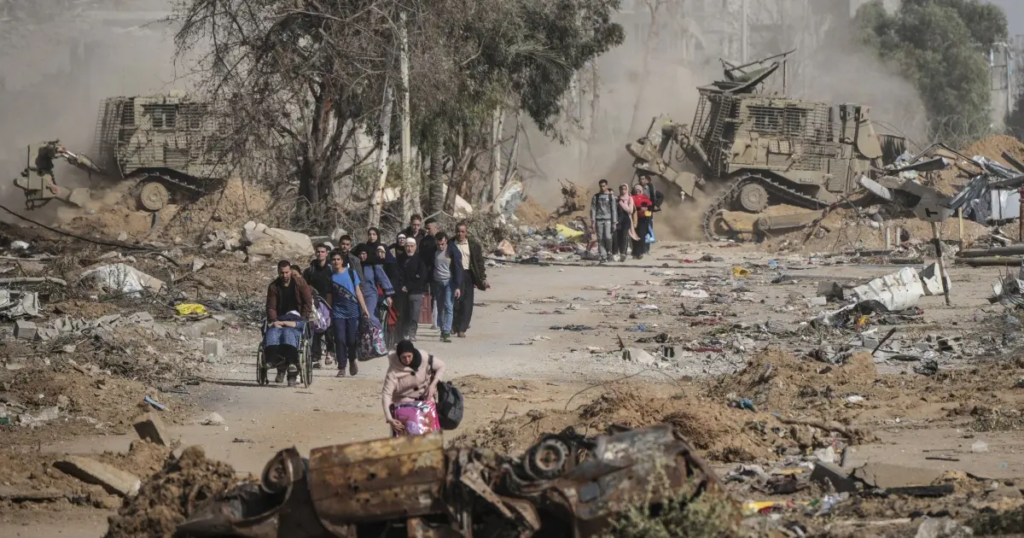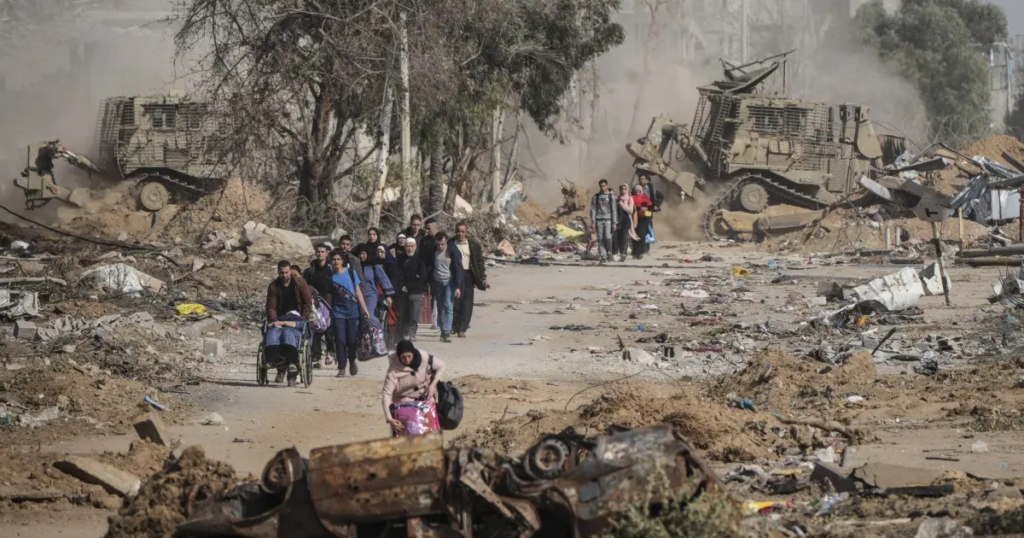The World Food Programme (WFP), a leading humanitarian organization under the United Nations, has recently found itself at odds with the White House over concerns surrounding Gaza aid distribution. Reports of restricted aid access, allegations of exclusion, and demands for greater transparency have sparked a public debate, raising questions about the United States’ role in addressing the humanitarian crisis in Gaza. This tension comes at a time when the region is grappling with severe food insecurity, exacerbated by ongoing conflict and logistical challenges. Below, we explore the details of this clash, its implications, and the broader context of humanitarian aid in Gaza.

Background: The Humanitarian Crisis in Gaza
Gaza, a small coastal territory, has faced significant challenges due to years of conflict, economic blockades, and political instability. According to the WFP, over 1.8 million people in Gaza—nearly 80% of the population—are experiencing acute food insecurity, with many relying on humanitarian aid to survive. The organization has been working tirelessly to deliver food, medical supplies, and other essentials to those in need. However, the delivery of aid has been hampered by restricted access, damaged infrastructure, and complex political dynamics.
The United States, a major donor to the WFP and other humanitarian organizations, plays a critical role in funding and facilitating aid efforts worldwide. In 2024 alone, the U.S. contributed billions of dollars to global humanitarian programs, including those in Gaza. Despite this support, recent developments have led to friction between the WFP and the White House, particularly regarding how aid is prioritized and distributed in the region.
The Clash: Allegations of Exclusion
At the heart of the dispute is the WFP’s claim that certain groups in Gaza are being excluded from receiving aid due to political and logistical barriers. While the WFP has not explicitly named the U.S. as the sole culprit, it has pointed to decisions made by key stakeholders, including the White House, that have limited the organization’s ability to operate effectively. According to a recent WFP report, bureaucratic delays and restrictions on aid convoys have prevented critical supplies from reaching some of the most vulnerable communities in Gaza.
The term “exclusion” has been particularly contentious. WFP officials have suggested that certain areas or groups in Gaza are being systematically overlooked, either due to security concerns or political considerations. For example, aid deliveries to northern Gaza, where conflict has been particularly intense, have been severely restricted. The WFP argues that these restrictions are not solely due to local conditions but are influenced by decisions made at higher levels, including by U.S. policymakers who oversee funding and diplomatic relations in the region.
In response, White House officials have defended their approach, emphasizing that the U.S. remains committed to supporting humanitarian efforts in Gaza. They argue that any limitations on aid delivery are due to security risks and the need to ensure that supplies do not fall into the hands of groups designated as terrorist organizations by the U.S. government, such as Hamas. The White House has also pointed to its ongoing diplomatic efforts to negotiate safe passage for aid convoys and improve coordination with international partners.

Transparency Concerns
Another major point of contention is transparency. The WFP has called for greater clarity in how aid decisions are made, particularly regarding the allocation of funds and the prioritization of certain regions or groups. In a recent statement, a WFP spokesperson stressed the need for “open and accountable processes” to ensure that aid reaches those who need it most. The organization has expressed frustration over what it perceives as a lack of clear communication from the U.S. government about how its contributions are being used.
Critics of the White House argue that the lack of transparency fuels mistrust among humanitarian organizations and the public. Some have pointed to the complexity of U.S. foreign policy in the Middle East, where geopolitical interests often intersect with humanitarian goals. For instance, the U.S. has maintained strong support for Israel, which controls many of Gaza’s borders and imposes restrictions on goods entering the territory. These policies have led to accusations that the U.S. is indirectly contributing to the exclusion of certain groups from receiving aid.
On the other hand, U.S. officials have pushed back against these claims, asserting that their processes are rigorous and designed to comply with international law. They argue that transparency is maintained through regular reporting to Congress and coordination with international partners like the WFP. However, the public nature of the WFP’s criticisms suggests that these assurances have not fully addressed the organization’s concerns.
The Broader Implications
The clash between the WFP and the White House has broader implications for humanitarian aid in Gaza and beyond. First, it highlights the challenges of delivering aid in conflict zones, where political and security considerations often complicate efforts to help those in need. The situation in Gaza is particularly complex due to the ongoing Israeli-Palestinian conflict, which has created a patchwork of restrictions and competing priorities.
Second, the dispute underscores the importance of international cooperation. The WFP relies on funding and logistical support from countries like the U.S., but it also needs the freedom to operate independently and make decisions based on humanitarian principles. When tensions arise between donors and aid organizations, it can undermine trust and hinder effective collaboration.

Finally, the controversy has drawn attention to the dire situation in Gaza. The WFP’s reports of widespread food insecurity have sparked renewed calls for action from the international community. Advocacy groups have urged the U.S. and other major powers to prioritize humanitarian needs over political considerations and to work toward a sustainable solution to the crisis.
Voices from the Ground
To understand the human impact of this issue, it’s worth considering the perspectives of those directly affected. In Gaza, residents have described the challenges of accessing basic necessities like food and clean water. “We wait for days, sometimes weeks, for aid to arrive,” said a Gaza mother in a recent interview with Al Jazeera. “When it does come, it’s never enough, and some areas get nothing at all.” These accounts highlight the real-world consequences of the restrictions and delays cited by the WFP.
Aid workers on the ground have also expressed frustration. A WFP field coordinator, speaking anonymously to Reuters, described the situation as “heartbreaking,” noting that bureaucratic hurdles often prevent them from reaching those in desperate need. These voices underscore the urgency of resolving the tensions between the WFP and the White House.
Moving Forward: Calls for Resolution
Both the WFP and the White House have expressed a desire to resolve their differences and improve aid delivery to Gaza. The WFP has proposed several steps, including streamlining approval processes for aid convoys, increasing funding for emergency food programs, and establishing clearer guidelines for how aid is distributed. The organization has also called for greater collaboration with local partners in Gaza to ensure that aid reaches all communities, regardless of their location or political affiliations.
The White House, for its part, has reiterated its commitment to supporting humanitarian efforts. In a recent press briefing, a State Department spokesperson emphasized that the U.S. is working with Israel and other regional partners to improve access for aid organizations. However, they also stressed the importance of balancing humanitarian goals with security concerns, a stance that is likely to remain a point of contention.
Conclusion
The clash between the World Food Programme and the White House over Gaza aid highlights the complexities of delivering humanitarian assistance in a conflict zone. Issues of exclusion and transparency are not just bureaucratic disputes—they have real consequences for millions of people struggling to survive in Gaza. As the international community continues to grapple with these challenges, the need for open dialogue, accountability, and a renewed focus on humanitarian principles is clearer than ever.
For more information on the situation in Gaza, visit Al Jazeera’s coverage or Reuters’ reporting on humanitarian aid. To learn more about the World Food Programme’s work, check their official site at wfp.org.
Also Know :- Dow Surges 740 Points on Eased Trade Tensions, Marking Best Day in 2025






